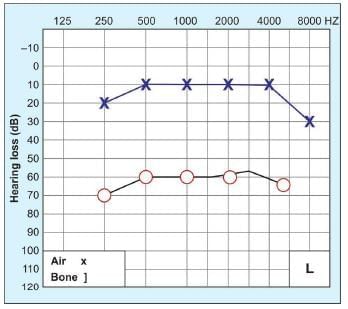NEET PG Exam > NEET PG Tests > Test: Physiology of Hearing and Audiology - 4 - NEET PG MCQ
Test: Physiology of Hearing and Audiology - 4 - NEET PG MCQ
Test Description
25 Questions MCQ Test - Test: Physiology of Hearing and Audiology - 4
Test: Physiology of Hearing and Audiology - 4 for NEET PG 2025 is part of NEET PG preparation. The Test: Physiology of Hearing and Audiology - 4 questions and answers have been prepared
according to the NEET PG exam syllabus.The Test: Physiology of Hearing and Audiology - 4 MCQs are made for NEET PG 2025 Exam.
Find important definitions, questions, notes, meanings, examples, exercises, MCQs and online tests for Test: Physiology of Hearing and Audiology - 4 below.
Solutions of Test: Physiology of Hearing and Audiology - 4 questions in English are available as part of our course for NEET PG & Test: Physiology of Hearing and Audiology - 4 solutions in
Hindi for NEET PG course.
Download more important topics, notes, lectures and mock test series for NEET PG Exam by signing up for free. Attempt Test: Physiology of Hearing and Audiology - 4 | 25 questions in 25 minutes | Mock test for NEET PG preparation | Free important questions MCQ to study for NEET PG Exam | Download free PDF with solutions
Test: Physiology of Hearing and Audiology - 4 - Question 1
Which of the following does not show negative Rinnes test in the right ear? (Exam 2016)
Test: Physiology of Hearing and Audiology - 4 - Question 2
If OAE are absent, the result is mentioned as: (Exam 2016)
Test: Physiology of Hearing and Audiology - 4 - Question 3
Reaction time for stapedial reflex is: (TN 2012)
Test: Physiology of Hearing and Audiology - 4 - Question 4
Raise of pressure from middle ear to inner ear (the ratio of (air) pressure across the tympanum during transmission of sound ) is:
Test: Physiology of Hearing and Audiology - 4 - Question 5
Negative Rinne test indicates: (Exam 2016)
Test: Physiology of Hearing and Audiology - 4 - Question 6
Most reliable test for Eustachian tube dysfunction: (AIIMS 2015)
Test: Physiology of Hearing and Audiology - 4 - Question 7
All of the following are involved in conductive deafness except: (Exam 2016)
Test: Physiology of Hearing and Audiology - 4 - Question 8
Shown below is an audiometry report. Interpret the audiogram and arrive at the most probable diagnosis: (AIIMS 2016)

Test: Physiology of Hearing and Audiology - 4 - Question 9
The centre for stapedial reflex is: (AIIMS 2016)
Test: Physiology of Hearing and Audiology - 4 - Question 10
Which of the following belongs to profound hearing loss according to WHO? (AIIMS 2016)
Test: Physiology of Hearing and Audiology - 4 - Question 11
What is the intensity in decibel of normal conversation in humans? (Exam 2016)
Test: Physiology of Hearing and Audiology - 4 - Question 12
Sound intensity of whispering is: (Exam 2014)
Test: Physiology of Hearing and Audiology - 4 - Question 13
Maximum hearing loss is caused by: (Exam 2016)
Test: Physiology of Hearing and Audiology - 4 - Question 14
Recruitment is seen in: (Exam 2016)
Test: Physiology of Hearing and Audiology - 4 - Question 15
All of the following are features of cochlear hearing loss except: (Exam 2016)
Test: Physiology of Hearing and Audiology - 4 - Question 16
Recruitment phenomenon is seen in: (Exam 2016)
Test: Physiology of Hearing and Audiology - 4 - Question 17
Objective method of hearing test: (Exam 2016)
Test: Physiology of Hearing and Audiology - 4 - Question 18
Screening test for neonate in ICU: (AIIMS 2016)
Test: Physiology of Hearing and Audiology - 4 - Question 19
C-shaped curve on tympanometry is seen in: (Exam 2016)
Test: Physiology of Hearing and Audiology - 4 - Question 20
Hearing loss at 65 dB, what will be the grade of deafness? (Exam 2016)
Test: Physiology of Hearing and Audiology - 4 - Question 21
Stenger test is used in diagnosis of: (Exam 2014)
Test: Physiology of Hearing and Audiology - 4 - Question 23
Otoacoustic emissions are absent when the following is damaged: (Exam 2016)
Test: Physiology of Hearing and Audiology - 4 - Question 24
All the following are features of sensorineural hearing loss except: (Exam 2016)
Test: Physiology of Hearing and Audiology - 4 - Question 25
True statement about Oto-acoustic emissions: (Exam 2016)
Information about Test: Physiology of Hearing and Audiology - 4 Page
In this test you can find the Exam questions for Test: Physiology of Hearing and Audiology - 4 solved & explained in the simplest way possible.
Besides giving Questions and answers for Test: Physiology of Hearing and Audiology - 4, EduRev gives you an ample number of Online tests for practice
Download as PDF














